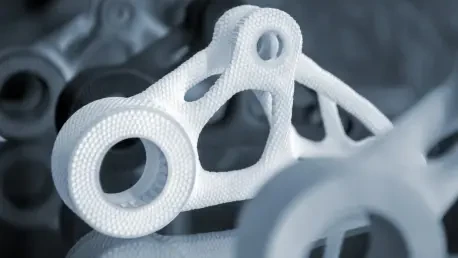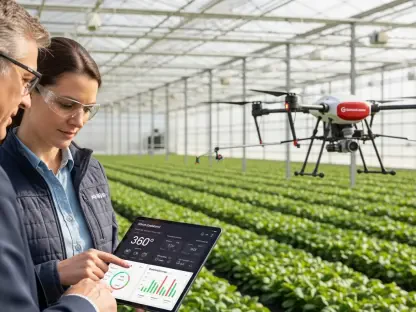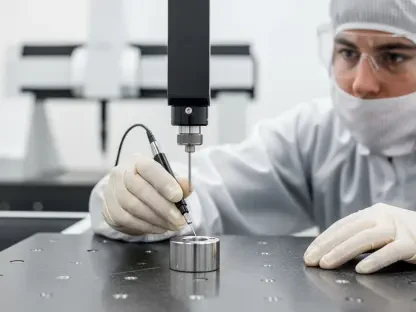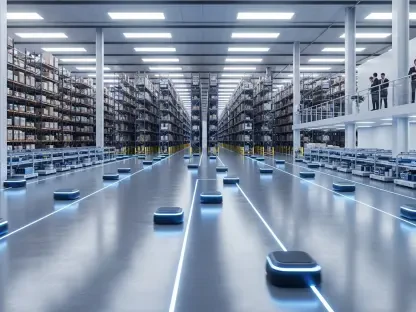In the rapidly evolving industrial world, additive manufacturing (AM), also known as 3D printing, continues to revolutionize production processes. As of 2025, the landscape of AM is marked by significant innovations that are reshaping industries, particularly aerospace, medical, and industrial sectors. The ongoing advancements in 3D printing technologies offer promising prospects for material properties and process optimizations. The article delves into these cutting-edge developments along with market dynamics and strategic business adaptations pivotal to the future of AM. The growing influence of AM in high-stakes applications underscores its potential to redefine traditional manufacturing methodologies.
Breakthroughs in 3D Printing Technologies
Research Innovations
The dawn of 2025 sees additive manufacturing at the forefront of technological transformation, driven by relentless research endeavors aimed at overcoming inherent technical challenges. Focused efforts spearheaded by leading research institutes and corporate laboratories are unraveling new dimensions in AM processes, seeking to enhance not only the variety of materials used but also the mechanical properties of the final products. Investigations into AM’s process optimization are fundamentally altering how businesses approach product design and manufacturing, leading to more resilient and sustainable products. Prominent initiatives include the exploration of novel geometric configurations and harmonization of layering techniques that promise significant gains in efficiency and material utilization.
These research efforts are not isolated but represent comprehensive collaborations across academic institutions and industry leaders. The cross-pollination of ideas facilitates advancements in integrating AM into existing supply chains while also pushing the boundaries of what is achievable. Another area of intense research focuses on the micromechanical properties of printed parts, including a detailed investigation into the interface between different materials within a single printed object and how this affects structural integrity. Such innovations hold immense potential, particularly for specialized applications where material performance under specific conditions is crucial. As research progresses, the insights gained are setting the stage for AM’s next evolution, promising to elevate the methodology beyond its current confines.
Alloy Advancements
In 2025, advances in alloy development continue to represent one of the most promising frontiers in additive manufacturing research. Aluminum and titanium alloys, in particular, are focal points of intensive study, serving as the backbone of many cutting-edge industrial applications. Researchers are delving deep into addressing notorious challenges like hot cracking and inherent porosity, which have long plagued AM processes. By precisely controlling alloy compositions and utilizing advanced simulation models, scientists are developing materials with enhanced performance characteristics capable of withstanding the stringent demands of aerospace and other precision-focused sectors.
One standout advancement in alloy research involves the meticulous fine-tuning of alloy microstructures to improve mechanical performance and resilience, including refining grain size, altering phase formations, and introducing new elements to improve mechanical properties and thermal stability. Efforts in this domain are focused on achieving materials that exhibit isotropic properties, minimizing the variance in mechanical attributes regardless of the part’s orientation during printing. Such breakthroughs are essential for ensuring the reliability and consistency of printed components. Broadening the range of usable alloys, researchers are experimenting with the introduction of specific trace elements known to significantly enhance certain desired properties, thus opening new avenues for alloy customization in AM. These strategic enhancements enable more intricate designs and functionalities previously unattainable with traditional manufacturing methods.
Material and Process Optimizations
New Element Integrations
Innovations in element integration within traditional alloy systems are reshaping the landscape of additive manufacturing. Researchers are increasingly exploring the benefits of incorporating elements such as niobium into established alloy matrices. These integrations are paving the way for advancements in mechanical strength and adaptability, crucial aspects for high-demand applications like aviation and medical implants. The strategic addition of elements aims to create an alloy that is not only strong but also lightweight, a combination particularly desirable in sectors seeking to improve performance while maintaining structural integrity.
The integration of novel elements is proving transformative by allowing for the customization of mechanical properties to suit specific applications. This adaptability is essential for industries requiring materials capable of withstanding extreme conditions. By modifying the structural and chemical composition at a molecular level, scientists are crafting materials with enhanced fatigue resistance and greater thermal tolerance. Furthermore, new element integrations extend the lifespan of components, reducing maintenance intervals and associated costs, thereby presenting a compelling case for their adoption in manufacturing processes. The continuous refinement in this domain aligns with the overarching objective of advancing AM to produce robust and durable components that meet the dynamic challenges of modern engineering.
Powder and Parameter Optimization
The meticulous optimization of powder characteristics and process parameters is central to the current advancements in additive manufacturing. In 2025, refining these variables is crucial for achieving superior mechanical properties and functional performance in printed parts. The article underscores the significance of manipulating powder attributes, such as size distribution, morphology, and surface properties, to improve the quality of the final output. Optimizing these parameters results in enhanced layer bonding and homogeneity, reducing common issues like porosity and ensuring the dimensional accuracy of complex parts.
Another cornerstone of process optimization is the fine-tuning of printing parameters—including laser power, scanning speed, and build orientation—which significantly impact the part’s microstructure and mechanical performance. The deliberate calibration of these elements not only maximizes material efficiency but also optimizes energy consumption, aligning with the global push toward sustainable manufacturing practices. Furthermore, developing sophisticated simulation tools enables manufacturers to predict potential issues and optimize settings before commencing the production phase, minimizing material waste and time delays. This integrated approach to optimizing powders and processes is revolutionizing additive manufacturing, ensuring consistent quality and expanding the range of applications for 3D-printed components.
Market Dynamics and Economic Perspectives
Industry Shifts
The article highlights current market dynamics reshaping the landscape of the additive manufacturing industry, accentuating the sector’s economic shifts as it grapples with fluctuating share values and strategic positioning. Major industry players, including 3D Systems and Markforged, are navigating an environment characterized by both opportunity and uncertainty. The article analyzes the industry’s responses to these challenges and the nascent strategies employed to maintain and enhance competitive advantage.
The volatility in market valuations reflects broader economic conditions, compelling companies to adopt adaptive strategies to weather potential downturns. The drive toward consolidation through mergers and acquisitions reveals an ongoing effort by these firms to streamline operations and expand technological capabilities. These maneuvers are vital in establishing economies of scale and solidifying market presence amidst stiff competition. Beyond financial implications, these shifts carry strategic importance as companies seek to align their core competencies with emerging market demands, fostering a landscape conducive to innovation and customer engagement. While economic uncertainties linger, the ability of firms to pivot and capitalize on their technological prowess remains a pivotal theme in navigating the complexities of the AM market.
Business Strategies
Within the competitive realm of additive manufacturing, businesses are strategically maneuvering to secure a stronghold in an evolving market. The article outlines how companies are crafting innovative business strategies to enhance market positioning and operational resilience. Strategic acquisitions have become a focal point, allowing companies to harness synergies that bolster their technological advances and market reach. By leveraging acquired technologies, companies can diversify their product offerings and access new customer bases, thus driving growth despite economic volatility.
An increasing emphasis is placed on forging collaborative ventures that foster a sharing of knowledge and resources, accelerating technological innovation. Further, many firms are channeling resources into the research and development of specialized applications, catering to niche markets with specific demands, such as custom medical implants or aerospace components. The alignment of business objectives with sustainable practices is also notable, as firms aim to minimize environmental footprint while maintaining efficiency and quality. These strategic directions underscore a holistic approach to ensuring business continuity, as companies endeavor not only to survive but to thrive by proactively responding to shifts within the AM industry landscape.
Industry Perspectives and Strategic Focus
Leaders’ Insights
Industry leaders provide valuable insights into the current state of additive manufacturing, shedding light on both the opportunities and challenges that lie ahead. There is a palpable sense of optimism as AM steadily moves past the earlier phases of heightened expectations toward delivering measurable value and practical applications. Conversations with these leaders reveal a clear trajectory toward embedding AM technologies within mature manufacturing processes, emphasizing a focus on delivering real-world, data-driven results rather than conceptual promises.
The dialogue emphasizes an emerging strategic focus that prioritizes value creation through innovation. With an expanded understanding of AM’s capabilities, companies are honing their operations to exploit technology’s potential, ensuring alignment with market needs and industrial standards. This informed approach underscores a commitment to achieving performance excellence while adapting to macroeconomic and geopolitical influences that impact supply chains and material availability. Industry leaders express confidence in AM as a pillar of future manufacturing innovation, prepared to overcome past hurdles and meet evolving consumer expectations with advanced, reliable products.
Future Outlook and Challenges
The article explores strategic insights into the future outlook of additive manufacturing, highlighting the challenges and necessary focus areas for sustained growth. There is a consensus among decision-makers on the essential nature of strategic clarity and execution in harnessing the full potential of AM technologies. With lessons learned from past experiences, there is a concerted effort to align technological investments with business goals, optimizing resource utilization and market positioning.
Future-oriented approaches involve strengthening partnerships across the value chain, from suppliers to consumers, to ensure a seamless transition of AM products from conception to market entry. This collaborative network is key to overcoming logistical and scalability challenges, enabling a more resilient manufacturing ecosystem. Real-world validation and certification processes are gaining prominence as industry players seek to instill confidence in AM-produced components’ quality and reliability. Understanding customer needs and adapting to technological trends lay the groundwork for leveraging AM innovations effectively. By acknowledging and addressing these future challenges, the industry is preparing to solidify its role as a transformative force in modern manufacturing.
Technological Trends in High-Stakes Sectors
AM in Aerospace and Medical Applications
Additive manufacturing’s technological advancements are increasingly pivotal to high-stakes sectors such as aerospace and medicine, where precision and performance are paramount. The article highlights the evolution of laser powder bed fusion and directed energy deposition techniques, which are becoming integral to manufacturing components with intricate geometries and exceptional material properties. These technologies provide unmatched flexibility in design, allowing engineers to create complex structures with enhanced functionality and reduced weight, essential characteristics in aerospace applications.
In the medical sector, these AM advancements are transforming the production of patient-specific implants and prosthetics, offering better alignment with individual anatomical structures and promoting improved health outcomes. The precision of these technologies enables the manufacture of implants that perfectly match patients’ needs, reducing the chances of rejection and ensuring more effective integration with human tissue. Moreover, the capacity for rapid prototyping and customization supports the development of innovative treatment solutions, pushing the boundaries of what’s achievable within healthcare. The ongoing breakthroughs in AM technologies continue to yield newfound opportunities, promising significant improvements in both aerospace performance and patient care quality.
Expanding Applications
The expanding scope of additive manufacturing technologies is enhancing their applicability across diverse industries, as highlighted in the article. The increasing sophistication of these technologies is enabling their deployment in scenarios previously dominated by traditional manufacturing methods. AM is being embraced for its potential to simplify production processes, reduce waste, and enable faster turnaround times, offering significant advantages in specialized industries such as automotive and electronics.
One notable trend is the growing application of AM in the production of tooling and fixtures, where its ability to create customized low-volume parts with complex geometries offers distinct advantages. The automotive industry, for instance, is leveraging AM for prototyping and developing lightweight vehicle components that contribute to improved fuel efficiency. In electronics, the utilization of conductive materials in AM processes is paving the way for the creation of innovative devices with more compact and intricate designs. The capacity of AM to adapt to specific requirements and provide tailor-made solutions is increasingly being recognized, opening avenues for ongoing research and application in fields demanding precision, agility, and innovation. The adoption of AM in these sectors signifies not only technological progress but also a shift towards more efficient and sustainable manufacturing practices.
Strategic Pathways and Considerations
In today’s fast-paced industrial environment, additive manufacturing (AM)—better known as 3D printing—is dramatically transforming production processes. As we approach the year 2025, AM is marked by groundbreaking innovations, particularly in sectors such as aerospace, medicine, and general industry. The advancements in 3D printing technologies promise improved material properties and process efficiencies, creating exciting new opportunities. This article explores the latest developments, market dynamics, and strategic business changes crucial to AM’s future. The increasing impact of AM on critical applications emphasizes its capacity to redefine conventional manufacturing methods.
The innovations have led to the creation of lighter, stronger materials essential for aerospace applications, where precision and durability are paramount. Meanwhile, the medical field benefits from 3D printing through the production of custom prosthetics and implants tailored to individual needs, presenting a tailored approach to healthcare solutions. Industrial sectors, too, are adopting AM for streamlining operations, reducing waste, and fostering sustainable practices. As businesses adapt to these technologies, they must consider strategic shifts to stay competitive in this evolving landscape. AM’s influence is evident as it moves from the fringes to the core of manufacturing processes, promising a more efficient and innovative future.









